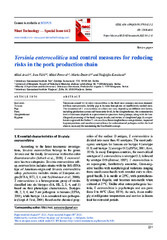Приказ основних података о документу
Yersinia enterocolitica and control measures for reducing risks in the pork production chain
| dc.creator | Arsić, Miloš | |
| dc.creator | Vićić, Ivan | |
| dc.creator | Petrović, Miloš | |
| dc.creator | Dmitrić, Marko | |
| dc.creator | Karabasil, Nedjeljko | |
| dc.date.accessioned | 2023-11-09T08:22:37Z | |
| dc.date.available | 2023-11-09T08:22:37Z | |
| dc.date.issued | 2023 | |
| dc.identifier.issn | 2466-4812 | |
| dc.identifier.uri | https://vet-erinar.vet.bg.ac.rs/handle/123456789/3330 | |
| dc.description.abstract | Yersiniosis caused by Yersinia enterocolitica is the third most common zoonosis transmitted from asymptomatic, healthy pigs to humans through raw or insufficiently cooked meat. The occurrence of Y. enterocolitica on a farm can vary, depending on different risk factors, including production system and biosecurity level. At the slaughterhouse, the contamination level of carcasses depends to a great extent on practices during lairage, along with the handling and processing of the head, tongue, tonsils, and rectum of slaughtered pigs. A comprehensive approach for further Y. enterocolitica farm/slaughterhouse categorization, improved hygiene practices, and mandatory surveillance for underestimated pathogens within the food chain is necessary for maintaining the One Health concept. | sr |
| dc.language.iso | en | sr |
| dc.publisher | Institute of Meat Hygiene and Technology | sr |
| dc.relation | info:eu-repo/grantAgreement/MESTD/inst-2020/200143/RS// | sr |
| dc.rights | openAccess | sr |
| dc.rights.uri | https://creativecommons.org/licenses/by/4.0/ | |
| dc.source | Meat Technology | sr |
| dc.subject | Yersinia | sr |
| dc.subject | Pigs | sr |
| dc.subject | Farm | sr |
| dc.subject | Slaughterhouse | sr |
| dc.subject | Hygiene | sr |
| dc.title | Yersinia enterocolitica and control measures for reducing risks in the pork production chain | sr |
| dc.type | article | sr |
| dc.rights.license | BY | sr |
| dc.citation.volume | 64 | |
| dc.citation.issue | 2 | |
| dc.citation.spage | 237 | |
| dc.citation.epage | 241 | |
| dc.identifier.doi | 10.18485/meattech.2023.64.2.43 | |
| dc.identifier.fulltext | http://veterinar.vet.bg.ac.rs/bitstream/id/9894/bitstream_9894.pdf | |
| dc.type.version | publishedVersion | sr |

